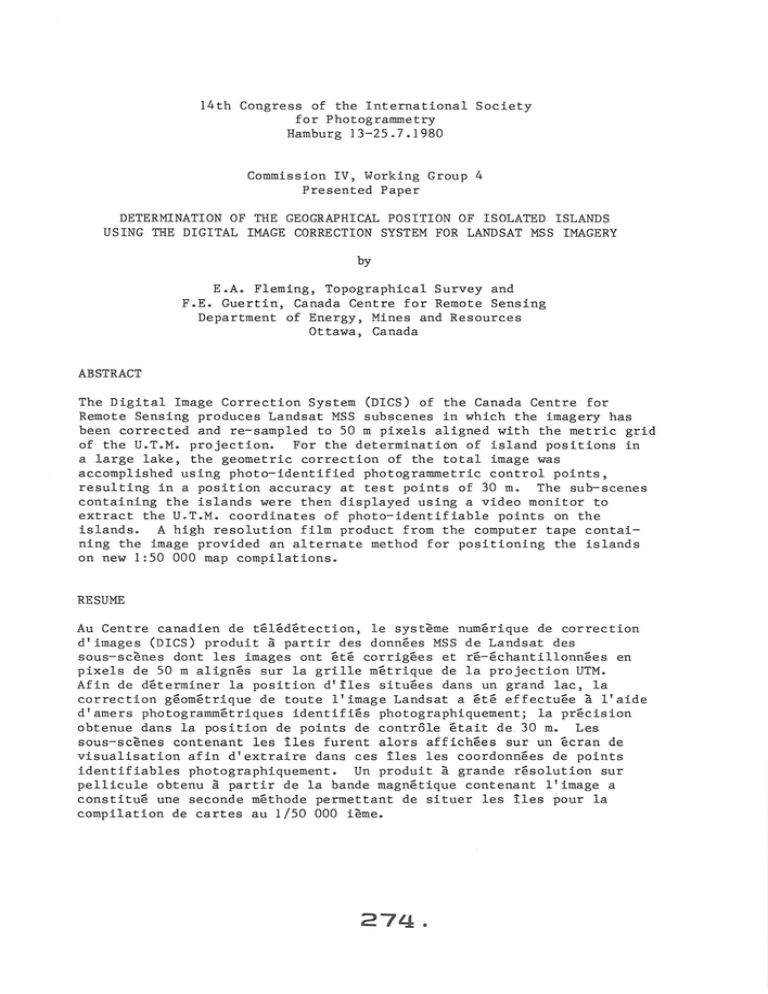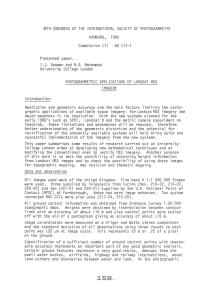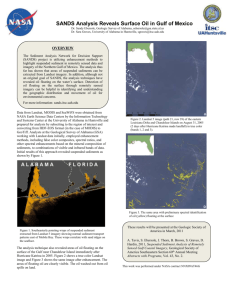14th Congress of the International ... for Photogrammetry Hamburg 13-25 7.1980
advertisement

14th Congress of the International Society for Photogrammetry Hamburg 13-25 . 7.1980 Commission IV, Working Group 4 Presented Paper DETERMINATION OF THE GEOGRAPHICAL POSITION OF ISOLATED ISLANDS USING THE DIGITAL IMAGE CORRECTION SYSTEM FOR LANDSAT MSS IMAGERY by E . A. Fleming, Topographical Survey and F . E. Guertin, Canada Centre for Remote Sensing Department of Energy, Mines and Resources Ottawa, Canada ABSTRACT The Digital Image Correction System (DICS) of the Canada Centre for Remote Sensing produces Landsat MSS subscenes in which the imagery has been corrected and re-sampled to 50 m pixels aligned with the metric grid of the U. T. M. projection. For the determination of island positions in a large lake, the geometric correction of the total image was accomplished using photo-identified photogramrnetric control points, resulting in a position accuracy at test points of 30 m. The sub-scenes containing the islands were then displayed using a video monitor to extract the U. T. M. coordinates of photo-identifiable points on the islands . A high resolution film product from the computer tape containing the image provided an alternate method for positioning the islands on new 1:50 000 map compilations . RESUME Au Centre canadien de teledetection, le systeme numer1que de correction d'images (DICS) produit i partir des donnees MSS de Landsat des sous-scenes dont les images ont ete corrigees et re-echantillonnees en pixels de 50 m alignes sur la grille metrique de la projection UTM . Afin de determiner la position d'iles situees dans un grand lac, la correction geometrique de toute l'image Landsat a ete effectuee a l ' aide d ' amers photogrammetriques identifies photographiquement; la precision obtenue dans la position de points de contr6le etait de 30 m. Les sous- scenes contenant les iles furent alors affichees sur un ecran de visualisation afin d ' extraire dans ces iles les coordonnees de points identifiables photographiquement . Un produit a grande resolution sur pellicule obtenu i partir de la bande magnetique contenant l'image a constitue une seconde methode permettant de situer les iles pour la compilation de cartes au 1/50 000 ieme . INTRODUCTION When conventional aerial photogrammetry is used , the mapping of offshore features, either along coastlines or in lakes is limited to a narrow band adjacent to the shoreline. Occasionally, in Canada, large expanses of water can be bridged if photography has been fortuitously acquired during that short period of time when the water is solidly frozen and the land is free of snow. More frequently however during map compilation it is found that some small island or groups of islands cannot be incorporated in the aerial triangulation and block adjustment because of water gaps between models . These islands and coastal features have generally been mapped in the past at smaller map scales, where they have been positioned by the best means possible at the time . Every effort, short of sending in a field survey, is made to verify, and if possible, improve the position of these features on new 1 : 50 000 map compilations . Landsat multispectral scanner (MSS) images have been used in the past for determining island positions (Fleming , 1977 ; Fleming and Lelievre, 1977) . In these instances, bulk processed Landsat images containing a variety of inherent distortions were used . By coordinate measurements in the image and affine transformation to either map-identified control or to photogrammetric control points, the image coordinates were transformed to U. T. M. coordinates . Only relatively small segments of the Landsat image were handled in this manner. In 1979 the Digital Image Correction System (DICS) developed by the Canada Centre for Remote Sensing for the geometric and radiometric correction of Landsat MSS images became operationally available (T . J . Butlin et al, 1978) . Concurrently a need arose in Topographical Survey to check the position of some islands in Dubawnt Lake, N. W.T . for new 1 : 50 000 mapping. The lake is approximately 100 km long and 60 km wide and contains at least 10 islands that are isolated from photogrammetric control by water gaps in the 1: 60 000 mapping photography. By combining the resources of the two organizations it was possible to test the DICS geometric correction capabilities and to produce position information in the U. T. M. system for the isolated islands . THE CCRS DIGITAL IMAGE CORRECTION SYSTEM To facilitate the integration of Landsat MSS imagery with other geobase information systems, the Canada Centre for Remote Sensing has developed a precision processed image product in the U. T . M. projection and made this available to users on computer compatible tapes . (Guertin et al, 1979) . These images are generated on DICS , a remote sensing image correction system composed of a PDP 11/70 minicomputer, standard peripherals, an image display terminal and a digitization table for control point acquisition, and a micro-programmed corrector for image re-sampling . The geometric correction method implemented on the DICS is based on the work carried out at CCRS on rectification, registration and resampling (Shlien, 1979) . The approach consists of defining a composite transformation from the corrected image to the uncorrected original 275. Landsat image. This process involves three transformations between four spaces : the corrected output image coordinates, the U. T. M. grid, the system-corrected input image and the original input image. The transformation between the U.T . M. grid and the corrected out~ut image is derived a priori from the pixel size and · the subscene framing. The system-correction transformation is a nominal transformation based on earth rotation, sensor delay, mirror scan non-linearity and aspect ratio. The rectification transformation consists of two bivariate correction functions computed by least squares estimation using control points identified between the N. T.S . maps of the area and the Landsat image . The locations of the control points are digitized on the maps and measured in the digital image using the display terminal . Once the transformation is known for an image, subsequent images of the same scene can be corrected by registration with the first image, (called the reference image) . The registration transformation is obtained by measuring control points in both images . These measurements can be made by the operator using the display terminal or by digital correlation of image chips . The DICS output product consists of a Landsat MSS 4-band subscene covering one quarter of a 1 : 250 000 N. T. S . map (0 . 5° latitude by 1 . 0° longitude) and is recorded on a computer compatible tape . In each band the pixel size is 50 x 50 metres registered on the one-kilometre U. T. M. grid . Hence the U. T. M. coordinates for all pixels expressed in metres are always multiples of 50 metres . Because the grid defined by the pixels is registered on the one-kilometre U. T. M. grid and because subscene dimensions are defined by the N. T. S. quadrangles, successive images of the same Landsat subscene will have the same number of pixels per line and the same number of lines . This facilitates the analysis of multitemporal imagery . The operations and data flow of DICS is shown in figure 1 . CONTROL POINT SELECTION The normal source of control for the DICS geometric correction is map-identified points whose U. T. M. coordinates are determined from the largest scale N. T. S . maps of the area . In over 60% of Canada, 1 : 50 000 maps are available for this purpose, with 1 : 250 000 being the largest scale available in the remainder of the country . This type of control has shortcomings if one wishes to evaluate the geometric transformation of the corrected image since a single Landsat image can cover from thirty to sixty 1 : 50 000 maps of different vintages, compilation techniques and accuracies . The best control base for establishing and testing the geometric correction of a Landsat image is that which results from aerial triangulation block adjustments of areas many times larger than single Landsat frames . Such an area of control was available as a result of the preparation for mapping at 1 : 50 000 of the area surrounding Dubawnt Lake . This control takes the form of U. T. M. values for all photogrammetric pass-points in the block . Although, the selection of pass-point locations in photogrammetric bridging is not made on the basis of their interpretability on a Landsat image, among the many thousands of such points it was not difficult to 276. Figure 1. DICS OPERATIONS AND DATA FLOW N. T. S. 11aps 0 Compute rad . /geom. correct ion parameters Perform rec./geom. correction Reference MSS CCT's N. T.S. compatible CCT's 1 0 Sensor Calibration file Input MSS CCT Figure 2. CONTROL POINT IDENTIFICATION DICS operator moves the crosshair cursor to the location of the control point . Enlargement of photogrammetric bridging diapositive showing location of the pass- point to be used as a control point for DICS . 277. select ninety uniformly distributed points in the area of an image that had this potential . Such points are generally located at some identifiable feature on the shoreline of a lake or island . In order to make these points useable in DICS , each pug-point identification was photographed and enlarged so that the pug-point itself was readily visible . This aerial photo identification was then compared with the Landsat band- 7 image on DICS where a display terminal is used to display portions of an image for control point identification. A track ball controls a cross-hair cursor which can be placed at the point on the image which the operator considers to be the location of the control point . The DICS offers image manipulation functions that can assist the operator in the identification of points . The portion of the image which is displayed can be digitally magnified by over- sampling the pixels using a Fourier kernel interpolator . Typically, an over-sampling factor of eight is applied giving an effective pixel size of 7 x 10 m. Also the radiometric contrast of the image is increased by computing the histogram of the pixel values and stretching the dynamic range of the data . These functions facilitate the visual identification and interpretation of the features . Although the Landsat MSS has an instantaneous field of view of 79 x 79 m it was found that the operator's designation of where specific control points were located did not vary by more than 12 m RMS, even when the measurements were made weeks apart . An example of control identification is shown in figure 2 . GEOMETRIC CORRECTION OF THE IMAGE The Northing and Easting coordinates in the U. T. M. projection obtained from the N. T. S . maps or from photogrammetric pass-points, together with the pixel and line number coordinates of the same points measured in the uncorrected image using the display terminal, serve to create a geometric transformation work file on the DICS . The points can be entered in the work file in any order . After a minimum of four points have been measured and recorded in the work file the operator can request a leastsquare affine transformation which is applied to the system- corrected location of the control points in order to allow for nominal non-linear distortions . The resulting transformation can assist the operator in predicting the location of more U. T. M. points in the uncorrected Landsat image . When more control points have been specified the operator can obtain a new transformation . Based on the location error associated with each point and derived from the transformation the operator can reject control points exhibiting large errors , and the transformation can be re-evaluated . The operator can specify the order of the leastsquare fit as first (affine), second, or third order . In the operational mode, twenty to thirty map-identified control points which are well distributed in the image are used to establish the final geometric transformation to be applied during the resampling of the entire Landsat image by the micro-programmed corrector . The redundancy of control points available in the Dubawnt Lake area made it possible to withhold some points at test points . The geometric quality of the image could then be examined after transformations involving various numbers of control points . 278. Figure 3 DIC S GEOMETRIC TESTING • control point 1---1 o test point 50 m . 0 I :.~g 0 0 0 "'(/ I .. 0 t 0 0 0 0 Dub awn t 0 0 0 c;:, a ~: 0 0 0 0 0 0 0 0 0 0 0 0 0 0 (a) 0 0 0 0 • 0 .. 0 0 0 0 (b) 5 CONTROL POINTS = 1 00 RMS at check points RMS at control = ' 0 0 ' 0 0 \ ... 'e 0 (c) Dubawnt Lake • '\ o \ '\ ~~1 ~)"U 0 0 ". ~ q- 0 .. 0 ... '\ ' \ "-.. .----- .... ... ..... ...... (d) ___. ' \ ' .. m 23 m The rectangle in (d) shows the area of the NTS 1:250 000 quadrangle covered by a DICS output CCT (Four 1: 50 000 maps) . 279. '- 55 CONTROL POINTS RMS at control points = 31 = ' ... J 25 CONTROL POINTS RMS at check points RMS at control ... fl .... .... \_ 0 0 -.' ', ~' 0 ..___ 0 i ~ '"~ • 0 j·vz ·os .... 0 ~u • v: 0 30m 23 m ' t · I ~~ ~ • 0 = = l. o ' 0 RMS at check points RMS at contr ol m 65 m 0 . .. 0 0 1 5 CONTROL POINTS '. 0 ....._ 0 0 0 = 26 m In the area of the test image it was possible to identify 55 out of the selected 90 pass-points and of these 29 were reserved as test points . Five, fifteen and twenty-five well-distributed points were selected as control for successive transformations and a final transformation was made using all 55 points . With five control points, only a first order transformation could be applied . The remaining transformations were second order . The results given in Table 1 show that the second order transformation using 15 points represented a stable transformation for this image . The residuals at control and the location of the test points are shown graphically in figure 3 . A second image transformed using 69 control points, exhibited almost identical residuals at control (25 m RMS) . TABLE 1 DICS GEOMETRIC ACCURACY Number of Control Points Used in Transformation RMS of Test Points (m) 29 points RMS at Control (m) 5 15 25 65 30 31 100 23 23 55 26 DETERMINING THE POSITION OF ISLANDS The results of the geometric test would indicate that the islands on the DICS digital image were located to within the map accuracy requirements of the 1 : 50 000 maps being prepared . However, defining island outlines or specific points on islands in order to reintroduce the position information into the photogrammetric compilation presents some problems due to the limited resolution characteristics of the Landsat scene . Two methods are being tried, and time will tell which is the more acceptable from a production standpoint . a) Photo-Identification of Specific Points : (Figure 4) Using the DICS display terminal, the cursor was placed either in the centre of a small island or on some coastal feature of a larger island and the position of the cursor was photographed as a photo- ident i fication of the point . The U. T. M. coordinates of the point in the corrected image were printed out on the operator console . These points are then plotted on the compilation manuscript and identified on the aerial photograph . b) Corrected Film Image: (Figure 5) Using an Optronics Scanning Microdensitometer, the DICS corrected Landsat product can be recorded on film as a high resolution, geometrically correct image at a scale of 1 : 250 000 for the required map sheets . This image can then be enlarged to precisely 1 : 50 000 , and although the image resolution is a limiting factor, the configuration of an island or island group is complete, and the positio~ of 280. Figure 4 . ESTABLISHING U. T. M. VALUES FOR ISLANDS Photo- identification of cursor position on tip of an island .... '· . ·........ ! : : '!; . .. :; ·i ·- . :: ·...· .:.:. --i 1. .i. Print- out of U. T. M. coordinates of point 281. .L :. !· aeria l photography of the same area can be adjusted to the best average fit . CONCLUSIONS The DICS corrected Landsat images make it possible to position is l ands with an accuracy which is comparable to the compilation standards set for these sheets . Had the posit i on infor ma t ion for the islands been derived from the current 1 : 250 000 mapping , position e r rors of up to 250m would have been carried over into the 1 : 50 000 mapping . Although operationally DICS uses control derived from N. T. S . maps , r ather than photogrammetric points , as the routine source of control fo r image rect i fication , i t has been shown i n this test that the system is capab l e of providing correction throughout the entire Landsat MSS image to an accuracy of 30 metres RMS . In many applications of remote sensing the two primary geometric prope r ties required of an image are that it has good conformity wi th the exi sting N. T. S. map and that there is good registration between mult i- temporal i mages of the same scene . These objectives can be attained using map- based control points, however the use of photogrammetric cont rol information would improve the absolute U. T. M. position accur acy of precision pr ocessed Landsat MSS images . REFERENCES Butlin , T. J . , Guertin, F. E., Vishnubhatla, S. S. (1978) The CCRS Digital Image Correction System, Proceedings of the fifth Canadian Symposium on Remote Sensing, Victoria, B. C., August 1978 . Fleming , E. A. (1977) Positioning Off- Shore Features with the Aid of Landsat Imagery . Photogrammetric Engineering and Remote Sensing, Vol . 43, No . 1, January 1977, pp . 53- 59 . Fleming, E. A. , Lelievre , D. D. (1977) The Use of Landsat Imagery to Locate Uncharted Coastal Features on the Labrador Coast . Proceeding of the eleventh International Symposium on Remote Sensing of Environment , Ann Arbor, Michigan, April 1977 . Guertin , F . E., Butlin , T. J . , Jones, R. G. (1979) La correction geometrique des images Landsat au Centre canadien de teledetection . Presentee au 3ieme Colloque International du GDTA, Toulouse , France, Juin 1979 . Shlien , S . (1979) Geometric Correction , Registration and Resampl i ng of Landsat Imagery . Canadian Journal of Remote Sensing ; Vol . 5, No . 1, May 1979 . 282. Figure 5 . DIGS GEOMETRICALLY CORRECTED IMAGE OF DUBAWNT LAKE A composite of two DIGS images at a scale of 1 : 500 000 showing the area in Dubawnt Lake which would be mapped by eight 1 : 50 000 maps . 283.




